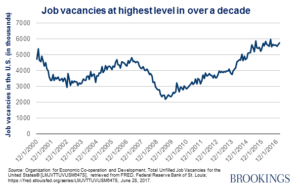(Editor Note: Insight Bytes focus on key economic issues and solutions for all of us, on Thursdays we spotlight in more depth Solutions to issues we have identified. Fridays we focus on how to build the Common Good. Please right click on images to see them larger in a separate tab. Click on the Index Topic Name at the beginning of each post to see more posts on that topic on PC or Laptop.)

Image: operationhope.org
The greatest threat to a civil society are people without hope. They are angry, feel the system is rigged and look for scapegoats as the cause of their poor economic standing. This group left out of the economic mainstreams is located in rural regions where globalizations has taken jobs, and in inner cities where companies have fled to the suburbs. These people that John Hope Bryant calls, The Invisible Class, are off the economic grid, and largely left out of the political mainstream as well except when they demonstrate on the streets when a policy has gone too far.
Economic independence is crucial if we have an economy that works for the 99 % not just the 1 %. To build economic opportunities our governmental policies and programs must ensure a level playing field for all people and support a high quality education for all income levels.
It is about building our society for the common good. It means enabling building enterprises, non-profits and organizations that serve people. Our policies should be about enabling the ability of people to build. We need to rethink our framing of labor from a cost to an asset which it always was. Capital means in the Latin root ‘knowledge in the head’ derived from the capital end of a column at the top in a building. Poverty is not about money so much as a dearth of relationships and know how to build the skills toward a productive life, where money is a indicator of success.
Somehow the early accountants working for middle age Venetian families invented double entry accounting systems with debits and credits called assets money, land and equipment while labor was labeled an expense. Labor is viewed as an expense to this day because the owner-entrepreneur has to pay employees to work. Workers have had the ‘cost’ yoke around their necks ever since. Yet, are employees really a cost? The staff are the ones doing the work, creating the product or service and solving the problems – money does not create the product or service only people do. CEOs are often heard to say that employees ‘are our key asset’ but then treats them like second class citizens in making policies in the company, gaining a fair share of the profits or enjoying job hours flexibility. Today, Wall Street applauds wages being stagnant for the 80 % while profits go up and wealth accumulates for The Elite.
We need to change our perspective about people and their labor. How do we build an economy that works for all? One way is to focus on enabling, The Invisible Class with economic independence. Bryant points out that most of these people have credit scores at 550 or below, so they can’t get jobs, buy automobiles, or purchase a home. In short they can’t participate in the economic mainstream. Bryant’s Operation Hope program teaches those in poverty how to increase their credit scores, start businesses and strategies for accumulating wealth. By bringing them into the economic mainstream they can begin to feel more confident about their lives and the future. Operation Hope has partnered with Bank of the West who invited Bryant to locate Operation Hope offices inside their branches. Bank of the West in a far reaching vision understands educating prospective customers on the good use of credit and finance will make them better customers and likely to come back for additional services.
We need to learn from programs like Operation Hope, understand its key elements and see how to implement its tenets and power on a major scale like the Marshall Plan if we are to make a dent in the level of poverty in the Heartland or cities. The only way we are going to increase the size of our economy in a fundamental way is to empower millions of workers who are out of the economic mainstream. We have more companies going bankrupt then new businesses being started for the first time since WWII. It is time to recognize we have people who are assets with innovative skills to can build an economy that works for all.












